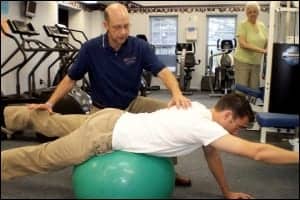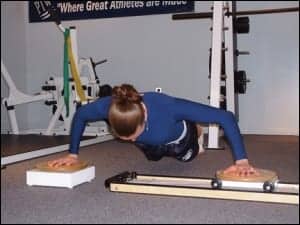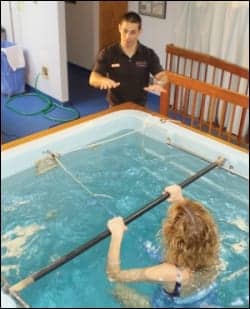With their propensity toward a young state of mind and determination to push boundaries of physical performance, recreational athletes may rely on physical therapists to keep them off the sidelines.

Robert Babb, PT, instructs tennis player Mark Farnsworth on the importance of proper technique.
A 49-year-old tennis player who had been in the clinic rehabilitating from an injury for just 3 weeks cemented plans with a buddy to play in an upcoming tennis tournament. As a recreational athlete, the man felt his knee was progressing enough that he could play in the tournament, even though his family physician told him to refrain from all sports for 2 to 3 months.
His outlook bolsters the theory that unlike past generations, today’s middle-aged folks still live in a young state of mind, pushing boundaries of physical performance in search of sensory stimulating excitement. They are today’s recreational athletes, sometimes called weekend warriors, defined by those who won’t take to the recommendation to avoid the activities that offer them the greatest endorphin release. As enablers in the health care system, physical therapists have to understand that some clients won’t slow down, and as a result, they will repetitively seek enabling, empathetic care. Today’s recreational athletes want to play hard, want speed, and want to pursue perfection in their game. They seek heavily soaked socks after a tennis match—so heavy it becomes difficult to take off the court shoes. They seek complete exhaustion after a 2-hour basketball game, despite running half the speed of their formal selves. They seek the satisfaction of walking 4 hours on a soft, green golf course while occasionally hacking away at a golf ball. They still want to be in the game, sometimes at a cost.
Opportunities are more mainstream than ever before, and growing, for the recreational athlete. Five-K runs, mini marathons, half-triathlons, individual and team sport activities, and all sorts of adventure sports create avenues of sport for all ages. Rehabilitation experts working to create a niche with this population potentially will be busy for decades to come.
VARIANTS OF AGING
The problem is that it’s not easy living the life of a recreational athlete. At some point, most will suffer injury and need professional help. Some do well in their chosen sport well into their eighth and ninth decades of life. How people age makes a difference in their recreational abilities. As people age, there is a higher likelihood of developing health problems. As health care providers offering education on recreational athletes, we can look at the chronological age predictors to understand what injuries are most common in recreational athletes and what the health care community can do to educate athletes and help them rehabilitate once injured. Biologically, it’s the ageing that refers to changes in the body that commonly occur as people mature. Because these changes affect some people sooner than others, some people are biologically old at 40, and others are biologically young at 60 and even older. A 50-year-old man who steps into a full court basketball game for the first time in a year is ignoring his biological age. A successful recreational athlete understands the attention to biological age that is needed while remaining psychologically young.
Psychological age is based on how people act and mentally feel, regardless of what their body is telling them. For example, a 60-year-old who on Monday schedules their Friday golf game, plans for work, looks forward to future events, and participates in many activities is considered psychologically young. That same person might ignore how the crepitus sounds from his knees fill the room as he gets out of bed in the early morning hours. By the time he arrives at work, he forgot that he woke at 2 am after rolling onto his sore shoulder. The psychologically young often use the phrase “it’s part of getting old,” even as their body is sending them signals to slow down or address a musculoskeletal problem. Recreational athletes psychologically have a positive self-image, and biologically are interested in overall wellness and injury prevention.
RECREATIONAL ATHLETES CRAVE KNOWLEDGE
Recreational athletes are in a constant state of attention to their biological age while living a young psychological age. Biologically speaking, they need to stay in shape in order to stay in the game, to continue to play their chosen sport. They understand the biological changes that occur in their body and want to learn more about facts such as reduction in oxygen exchange, fraying of soft tissue, loss of water content in the discs of the low back, demineralization of bone, and a whole host of other factors. They are paying attention to their biological age and they seek out professional help. Recreational athletes have a thirst for knowledge, and in many cases an insatiable appetite for more information. This foundation of knowledge combined with a young psychological age (they still “want in”) are what creates a recreational athlete’s mind, allowing them to accept every physical challenge that comes their way. This will create a need for rehabilitation experts to educate the athletes about their pursuits of higher levels of performance.
PATIENT DEMOGRAPHICS
A review of data from The Physical Therapy & Wellness Institute spanning 2008 and 2009 includes more than 2,900 new patients seen at our facilities. Of this population, 239 of the injuries were nonoperative and private insurance, and had discharge information that included “return to previous recreational activities.” The average age of this group is 44 years old, with the youngest at 15 and the oldest at 66. The most common 10-year age range with this group was 45 to 55 years old.
COMMON TYPES OF INJURIES

Functional pushups with rotating boards prepare a shoulder patient for return to action.
Low back pain. It is well documented that more than 90% of all individuals will experience some sort of low back pain in their lifetimes. Those who are young in psychological age often have a “wait-and-see” mentality, and come into the therapy centers with back pain, spasms of subacute pain to chronic in nature. With the recreational athletes’ thirst for knowledge, our staff members spend a significant amount of time teaching these folks Back Aide, a combination of early intervention techniques that include ice, medications (as recommended by their physician), rest, positioning, and early stretching and stabilization exercises. Education and instruction in proper dynamic movement patterns are practiced and rehearsed, including teachings to reduce segmental motion with daily activities and recreational sports. We believe this is a piece of the low back puzzle ignored by rehabilitation experts.
Soft tissue strain. The old adage that you train to play a sport or play a sport to get in shape holds true here. Muscle strains often occur as a result of overuse, underuse, lack of warm-ups or cooldowns, or poor sport-specific training. Muscle fibers are stretched beyond their abilities, and tears or pulls need to be addressed early by reducing soft tissue inflammation and gradual return to stretching, conditioning, and sport activities. Education about early injury inflammation and recovery cycles helps our clients understand self-treatment now and into the future.
Shoulder pain/rotator cuff strain/impingement syndrome. Naming a recreational sport that does not include use of the shoulders is difficult. If recreational athletes play a sport to get in shape, the shoulder joints seem most vulnerable, particularly as individuals reach their fifth and sixth decade of life. Superimpose mechanical stresses to the subacromial space on a normal rotator cuff that weakens and frays as you age, and you have a recipe for painful shoulders that will keep rehabilitation professionals busy. Educational tools including 3-D models, posters, and handouts build knowledge so once clients leave the clinic, they understand the concept of shoulder joint protection.
Knee pain/chondromalacia/ACL tear. The patella femoral joint is most susceptible to minor injuries when starting an athletic endeavor, most certainly with those not in condition to properly play a sport. Women, particularly younger women, far outnumber men with patella femoral pain, and are more likely to seek medical intervention for assistance. For runner’s knee or chondromalacia patella, 3-D models are used in our clinic to help clients understand the misalignment of the kneecap in its groove. The same models are used to help recreational athletes understand the consequences of a ruptured ligament, most commonly the anterior cruciate ligament. A model demonstrating instability of the tibial-femoral joint clearly shows the shearing that occurs as a result of a joint devoid of a critical ligament.
STRATEGIES FOR TREATING RECREATIONAL ATHLETES

Jim Fagnani, DPT, provides instruction in pool exercises for client Kim Smith.
Educating clients is the foundation of successful rehabilitation. Recreational athletes have a thirst for knowledge, they want to get back in the game, and they will take advice from a professional. We often direct patients to WEBMD.com, and print information for patients from that site to reinforce what we have discussed. Krames Communications educational handouts are a part of our practice, demonstrating a level of professionalism unlike others. Large, life-size posters dominate our walls, offering our therapists the chance to review muscle function. Three-dimensional models from American 3B Scientific (www.a3bs.com) of the foot, knee, hip, back, shoulder, and neck help the therapists explain kinematic movement, actions and reactions, muscle function, disc space, and more of the injured area. As a whole, your patients are visual learners, and viewing a model often helps them.
SIMPLE HOME EQUIPMENT
Much effort has been dedicated to developing home exercise equipment, home exercise instruction software, fancy ice packs, and more. Recreational athletes often seek evidence-based instruction, something to get them back to their game in the shortest period of time. A study conducted some years ago concluded the average patient will perform only four assigned exercises, regardless of the amount issued. Using this information, we try to develop a home program that isolates the problems found in the initial evaluation only. For instance, though a patient who presents with a teres minor is weak, but has a clear capsular pattern, we are most likely to have him perform passive range of motion exercises, pendulums, and self-mobilizations, and target specifically the teres resistance with manual techniques during their visits to the clinic. In this case, a weighted stick or a broomstick with ankle weights may be recommended. Socks filled with dirt can be tied to a stick, or a hammer taped to a broomstick might provide all the added weight needed. In addition to the home exercise handouts all of our patients receive (a great promo too, with our logo), they may receive a band, putty, or even a T-shirt.
BI-ANGULAR EQUIPMENT
With today’s significant insurance-driven physical therapy limitations, recreational athletes often continue their therapy independently at their health club, at school, or even on vacation/traveling. In all cases, we ask them to seek bi-angular exercise equipment for their strengthening needs, perhaps even cable-driven units, building on the foundations we teach that individuals rarely move in a single plane of movement. For instance, shoulder patients who rehabilitate at PTW would likely have worked their periscapular muscles on a bi-angular seated row, cable unit, in closed chain (total body units). As a result, they would have the education and proper habits formed, and could apply the technique in their chosen workout centers.
CARDIOVASCULAR EQUIPMENT
Cardiovascular equipment is useful only if clients understand the parameters of duration, intensity, and intervals. Physical therapists at PTW are expected to teach soccer players use of the treadmill in shorter intervals, varying speeds, for duration. Even though the athlete may be in our clinic for a short period and train on the treadmill for 15 minutes, it builds their foundation of knowledge for future decisions. As an added practice builder, this knowledge becomes customers’ kitchen-table conversation, helping them educate their family while helping us build our business. In general, we will make our decisions on cardiovascular training and conditioning from least compressive to most compressive. As an example, a 22-year-old basketball player with a recovering MCL strain may start running in the pool, progress to the Nu-Step, to the elliptical, followed by the treadmill, then finally use the plyometric boxes.
ENABLERS WILL HAVE CUSTOMERS FOR LIFE
As many family physicians will tell you, recreational athletes just don’t listen; they don’t slow down, even if physicians have told them to stop the sport. As physical therapists, we take on the role as an enabler. Just when others were telling them to stop a sport, we help, through education and tools of the trade, by enabling the recreational athlete. As enablers, we build friends for life, listening to our customers’ goals, and helping them get back into their game.
Robert Babb, PT, MBA, is the founder and president of The Physical Therapy & Wellness Institute, Lansdale, Montgomeryville, and Quakertown, Pa. He is a licensed physical therapist with more than 25 years of experience in the field. Over the years, he has helped individuals with acute and chronic injuries, work injuries, and sports injuries—from everyday athletes to members of the NFL’s Philadelphia Eagles—get back to their playing fields. For more information or .


